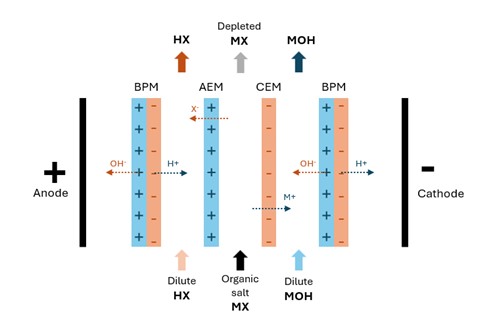In response to the increasing greenhouse gas emissions, deep CO2 removal from industrial flue gases is crucial for industries aiming to achieve carbon neutrality by 2050. The established amine-based technology, although widely used, suffer from several drawbacks such as thermal and oxidative degradation leading to toxic emissions and limit CO2 regeneration to 90-95 %. Aqueous hydroxide solvent used as adsorption liquid represent a promising alternative for their stability and non-volatility. Therefore, new electrochemical regeneration process combining acid-base neutralization and electro-membrane regeneration could achieve deep decarbonization, targeting over 99% carbon capture.
The project aims to the fabrication of a green, fully sustainable electro-membrane (EM) regeneration device to be integrated into the circular CO2 capture process. As part of “Electrified CO2 Capture Process to Achieve Net Zero Emissions (ECCSTAZE)” project, a bipolar membrane (BPM) combined with the conventional principles of electrodialysis will be used for its effectiveness for acid base regeneration from their corresponding salt solution (Figure 1) . However, membranes used so far involve petroleum-based solvents in their fabrication, restricted by REACH legislation due to their toxicity, necessitating a shift to more sustainable production methods.
The study will primarily focus on developing a sustainable bipolar membrane fabricated using the electrospinning technique with green solvents, and, potentially, biopolymers. To enhance the efficiency of the regeneration stack, different methods will be explored, such as geometrical entanglement, water-based polyelectrolytes and metal catalysts, aiming to promote water dissociation occurring in the interfacial layer (Figure 2). Following, membranes characterization and performances evaluation will be investigated and related to energy consumption and efficiency analysis, tailoring the membrane for optimal design and cost-effectiveness.

Figure 1. Typical configuration of a bipolar membrane electrodialysis unit for organic acid regeneration

Figure 2. Left: Electrospun mat before compression; Right, in the order: a) traditional laminated BPM, b) compressed electrospun BPM, c) compressed electrospun BPM with modified IL
Contact details:
Rebecca Rovai
Helix, STO 0.50
e-mail: r.rovai@tue.nl